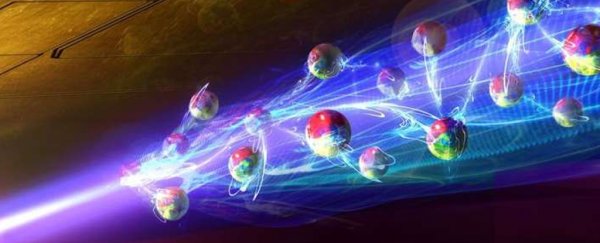Physicists have just caught light acting the part of 'glue' between atoms, in a kind of loosely bonded molecule.
"We have succeeded for the first time in polarizing several atoms together in a controlled way, creating a measurable attractive force between them," says University of Innsbruck physicist Matthias Sonnleitner.
Atoms connect to form molecules in a variety of ways, all involving a trade of charges as a kind of 'superglue'.
Some share their negatively charged electrons, forming relatively strong bonds, like the simplest gasses of two conjoined oxygen atoms we constantly breathe in, to the complex hydrocarbons found floating in space. Some atoms attract by virtue of differences in their overall charge.
Electromagnetic fields can alter the arrangements of charges around the atom. Since light is a rapidly changing electromagnetic field, a shower of appropriately directed photons can nudge electrons into positions that – in theory – could see them bond.
"If you now switch on an external electric field, this charge distribution shifts a little," explains physicist Philipp Haslinger from the Technical University of Vienna (TU Wien).
"The positive charge is shifted slightly in one direction, the negative charge slightly in the other direction, the atom suddenly has a positive and a negative side, it is polarized."
Haslinger, TU Wien atomic physicist Mira Maiwöger and colleagues used ultracold rubidium atoms to demonstrate that light can indeed polarize atoms in much the same way, which in turn makes otherwise neutral atoms become a little sticky.
"This is a very weak attractive force, so you have to conduct the experiment very carefully to be able to measure it," says Maiwöger.
"If atoms have a lot of energy and are moving quickly, the attractive force is gone immediately. This is why a cloud of ultracold atoms was used."
The team trapped a cloud of around 5,000 atoms below a gold-coated chip, in a single plane, using a magnetic field.
This is where they cooled the atoms down to temperatures approaching absolute zero (−273 °C or −460 °F), forming a quasicondensate – so the rubidium particles begin acting collectively and sharing properties like they're in the fifth state of matter, but not quite to the same extent.
Struck with a laser, the atoms experienced a variety of forces. For example, radiation pressure from incoming photons can push them along the light beam. Meanwhile, responses in the electrons can draw the atom back towards the most intense part of the beam.
To detect the subtle attraction thought to arise between atoms in this torrent of electromagnetism, the researchers needed to do some careful calculations.
When they switched off the magnetic field, the atoms free-fell for around 44 milliseconds before reaching the laser light field where they were also imaged using light sheet fluorescence microscopy.
During the fall the cloud naturally expanded, so the researchers were able to take measurements at different densities.
At high densities, Maiwöger and colleagues found up to 18 percent of the atoms were missing from the observational images they were taking. They believe these absences were caused by light-assisted collisions kicking the rubidium atoms out from their cloud.
This demonstrated part of what was happening – it wasn't just the incoming light that was influencing the atoms, but light scattering off the other atoms too. As the light touched the atoms it gave them a polarity.
Depending on what type of light was used, the atoms were either attracted or repelled by greater light intensity. So they were either pulled towards the region of lower light or higher light – in each case they ended up accumulating together.
"An essential difference between usual radiation forces and the [light triggered] interaction is that the latter is an effective particle-particle interaction, mediated by scattered light," Maiwöger and colleagues write in their paper.
"It does not trap atoms at a fixed position (for example, the focus of a laser beam) but draws them toward regions of maximum particle density."
While this force gathering the atoms is a lot weaker than molecular forces we're more familiar with, over large scales it can add up. This can shift emission patterns and resonance lines – features astronomers use to inform our understanding of celestial objects.
It could also help explain how molecules form in space.
"In the vastness of space, small forces can play a significant role," says Haslinger.
"Here, we were able to show for the first time that electromagnetic radiation can generate a force between atoms, which may help to shed new light on astrophysical scenarios that have not yet been explained."
This research was published in Physical Review X.
